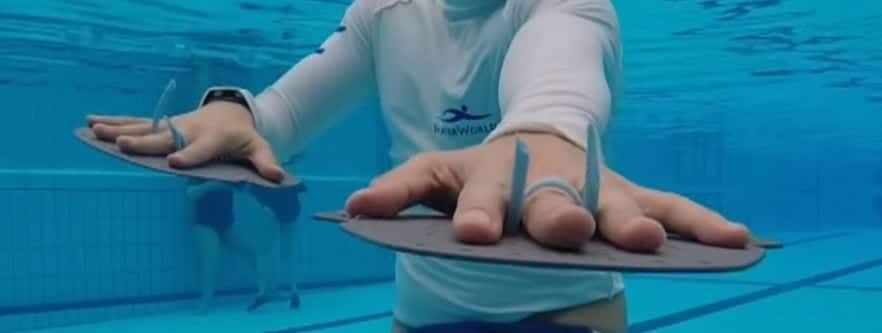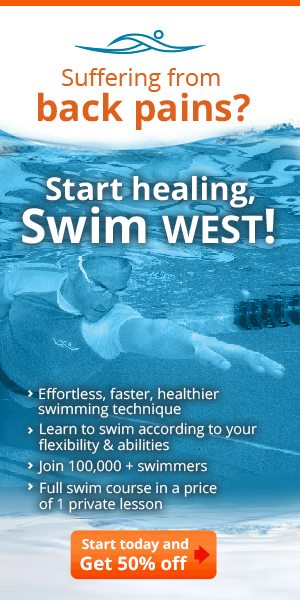Swimming with paddles
All of the questions you were too shy to ask… about paddles.
Swimming Paddles- why do we need them? How do you choose the right pair for you? What is it the proper way to use them?
*before you start…
Some swimmers work on shortening their muscles, working on power before working on their swimming technique or even worse, before learning how to swim correctly.
WEST swimming technique coaches don’t recommend working with paddles before you swim 1000m (1100 yards), And after you swim less than 20 strokes for 25 m(less than 19 strokes for 25 yards). WEST swimming technique works on protecting your neck and lower back in swimming and especially when learning how to swim.
Why do we need paddles for?
“Paddles”, my own personal gym, strengthens significantly your upper body and elongates your muscles, and creates the ‘swimmer long muscles’. The paddles allow us to grab the water better, therefore increasing our progress rate per stroke. Our goal is to train those muscles, so when we take our pedals off we still pull the same amount of water.
How do you pick the right pair for you? And what types of paddles are there?
There are many paddle shapes- duck shape, fingers shape, long ones and the standard type. The goal is to have our palm loose (which means having the fingers just a bit open, and not tight together) without having our fingers extending out of the pedal borders (there should be a 1cm gap between the fingers and the edge of the paddle). It creates an even scattering of the tension created by our palm, forearm, arm and shoulder, on the paddles. The smaller pedals allow us to grab the edge of it, so it doesn’t slip, but at the same time it creates lots of tension on our wrist, and an inflammation later on.
What is the proper way to use the paddles?
There are swimmers who swim with equipment on (pull buoy and paddles) significantly faster, compared no having nothing on. For example- if a swimmer goes a 200 on a 3:20 with no pull buoy, he can probably go 5-10 seconds faster with a pull buoy. On the other hand, a triathlete or a marathon runner could go 20 seconds faster with a pull buoy on. Keep in mind that a swimmer who is not used to swim with paddles, in theory, could go slower, since his stroke isn’t skilled enough.
So what is the reason that swimmers go faster with paddles and a pull buoy? And what should they do in order to catch up? Since runners have short and heavy leg muscles, they tend to sink easily, so the pull buoy and paddles can come very handy. There is no kicking with the pull buoy, which is a major energy depletion process for runners. They float better with the pull buoy and paddles and save up their legs. It all comes to a better body position in the water. In addition, the pedals give a larger surface area, increase our pulling volume and speed up our progress pace per stroke.
Pulling depth (emphasis #5)- varies between 10-50cm, depending on one’s scapula and neck flexibility, as well as the intensity of the workout, which puts tension on the shoulders. For example, when swimming easy, it’s reasonable to stretch the arm to a 5-10cm depth. When going hard, or doing a pedals set, we tend to start pulling deeper, so we lose stroke area. The good thing is that the neck is still protected.
Many swimmers tend to break the streamline by uplifting their palm, so they literally block their own forward movement. This bad habit puts tension on the neck, wrist, as well as slows you down and makes you lactate out sooner.
In order to keep a continuous streamline (especially between the palm and arm), or in other words, to avoid the ‘palm block’ described earlier, we recommend keeping your arm and palm in one continuous plain. Here’s a picture to demonstrate-
Here’s a drill to try for practicing the right angle, in which your palm should enter the water- swim with your head up above water, looking at your palms entering the water. Make sure you stretch your arm out AFTER you elbow has entered the water, to a 10cm depth. This drill’s goal is to have a close look (30cm away) of the entrance angle, so we can see if it’s the right and accurate one. Later on, the right angle will allow us to practice the proper stroke, as well as ‘leaning on’ the water, and avoiding shoulders injury. If you have a difficult time practicing it, you may do so with fins on.
To sum up, swimming with pedals is very important factor of powering up and technique improvement. It is highly recommended you consult WEST staff and pick the right pair for you. Do not attempt going long distances with pedals, unless in a gradual way. Furthermore, it is extremely important to listen to your body and work by the pointes mentioned throughout this article. If you suffer any pain, drop the pedals and do not stretch your arms in the water as deep.
Pedals and pull buoy are valuable tools for strengthening, but must be used properly.
If you do want to work on your swimming technique fill in the questionnaire and an on-line WEST swimming program will be send to you (according to your flexibility and swimming level) https://swim-west.com/diagnosis/
The writer of this article is Ori Sela founder of WEST swimming technique and the owner of Water World Israel – one of the biggest and most professional clubs for Hydrotherapy in the world.



